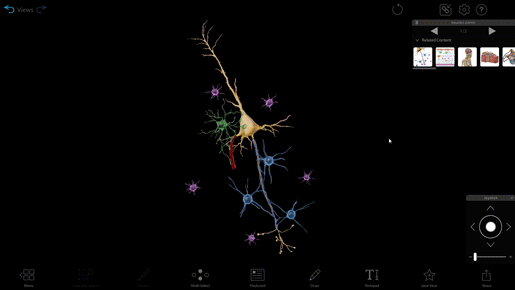Rabies: A Deadly Viral Disease
Posted on 7/21/23 by Sarah Boudreau
Unlike many other viral diseases, rabies is ubiquitous in our culture—if someone is angry, we say they’re “foaming at the mouth,” and if they’re enthusiastic about something, we say they’re “a rabid fan.” But what actually is human rabies?
Today on the Visible Body Blog, we’re talking about this deadly disease, how it’s transmitted, and how it’s treated.
Contracting Rabies
Rabies is caused when a virus in the genus Lyssavirus is transmitted through saliva of an infected animal. An animal in an early stage of the disease appears healthy, and might even act friendly towards humans, but these animals are quick to bite at the most minor provocation.
It doesn’t take a severe bite to transmit the virus—even superficial lesions can lead to rabies and in humans, dog bites cause about 99% of rabies cases. Globally, most cases of rabies in humans result from dog bites, but in the United States, the number one culprit is bats.
It’s extremely rare, but in a handful of cases, humans have developed rabies from receiving an organ transplant from an infected person.
When a bite from an infected animal breaks the skin, the virus can reach the peripheral nerves, entering at the synapse level. Once the virus is transported to the central nervous system, it replicates. The area of the brain affected by rabies depends on which motor neurons are present at the bite location. After it has reached the brain, the virus spreads to the salivary glands.
.jpg?width=515&height=386&name=My%20project%20(48).jpg)
Location of the salivary glands in humans. Image from Visible Body Suite.
Stages of Rabies
There are five stages of the disease; let’s go through each one.
The first stage is incubation. The incubation period can range from weeks to months. Animals in this stage can’t pass rabies along through a bite because the virus hasn’t yet made its way to the saliva.
The second stage is prodrome. During this stage, patients experience flu-like symptoms like fever, gastrointestinal issues, and muscle pain. They can also experience pain, itching, and a tingling sensation.

Neuron. GIF from Visible Body Suite.
The third stage is acute neurologic illness. The symptoms at this stage depend on what type of rabies the patient has: furious or paralytic.
Furious rabies is the most common, present in about 85% of cases. Symptoms of furious rabies include:
- Agitation
- Hypersalivation
- Autonomic dysfunction
- Increased deep tendon reflexes
- Neck stiffness
- Babinski sign, where the toes fan out when the bottom of the foot is stroked. This is a reflex that children under the age of two have, and in anyone older than that, it’s a sign of a neurological problem.
- Hydrophobia and aerophobia
Why hydrophobia? The muscles in the throat begin to paralyze, leading to throat spasms, and people develop a fear of drinking liquids. People with rabies may also develop aerophobia, becoming afraid of fresh air, drafts, or air blown into the face.
Paralytic rabies patients have a longer acute neurological phase, and they do not usually have hydrophobia or irritability. Instead, they experience
- Weakness
- Fever
- Bladder dysfunction
- Altered mental state
- Paralysis
The final two stages of rabies are coma and death. Coma typically begins within ten days of symptoms, and most patients die within two to three days of coma.
Tackling Rabies
Prevention is humankind’s number one defense against rabies. Vaccinating dogs is important and has led to huge reduction in rabies in some areas.
If a person is bitten by a rabid animal, they should first wash the wound thoroughly and then immediately seek medical attention. The patient will receive rabies postexposure prophylaxis, which contains human rabies immune globulin and the rabies vaccine. Human rabies immune globulin gives the immune system antibodies to fight the virus before the body produces antibodies of its own in response to the vaccine. 30,000 to 60,000 people receive rabies postexposure prophylaxis in the United States every year!
Postexposure prophylaxis is administered only on the day of exposure, then the vaccine is administered again on days 3, 7, and 14. It’s crucial to receive these shots after a bite because there is no proven treatment for rabies once symptoms occur.
If the patient has previously been immunized against rabies, additional vaccination is still needed on the day of the bite and on day 3. People like veterinarians or wildlife professionals who handle bats are advised to get pre-exposure prophylaxis vaccinations to reduce the number of vaccinations they would need if they came into contact with rabies.
Rabies and Survival
It is extremely rare to survive rabies without the series of shots. About 59,000 people die of rabies every single year, but there are only around 20 known cases of surviving rabies worldwide.
.jpg?width=515&height=386&name=My%20project%20(49).jpg)
Even surface-level lesions can lead to rabies. Skin model image from Visible Body Suite.
Because of the terrifyingly low survival rate without the vaccine, it made news that in 2003, an American teenager survived rabies. A bat bite gave the fifteen year old Wisconsin girl rabies, and by the time she was brought to the hospital three weeks after the bite, she had to be intubated in order to breathe. Too late for the vaccine regimen, she was put into a medically induced coma and given a series of antivirals. Against the odds, the patient survived. The Milwaukee protocol, as the treatment process has come to be known, has been replicated dozens of times since and has seen several revisions. However, there is very little evidence that the protocol actually works, and there are at least 31 documented failures.
Dr. Rodney Willoughby, the doctor who treated the surviving patient, has theorized that treatment may have only worked because she may have been infected with a rare, weaker version of the rabies virus.
Rabies remains a death sentence to those who do not receive prompt post-exposure vaccinations, which is why it’s crucial to vaccinate pets and improve medical care in developing countries, where the vast majority of human rabies deaths occur.
Read More
Want to read more about pathology? Check out these blog posts!
- What Makes Lyme Disease Tick
- 3 Real Diseases That Influenced Vampire Folklore
- 4 Fascinating Facts About Vaccine History
Be sure to subscribe to the Visible Body Blog for more anatomy awesomeness!
Are you an instructor? We have award-winning 3D products and resources for your anatomy and physiology course! Learn more here.



